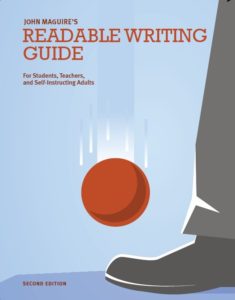Tammy Tilley asked:
You outline the number of weeks for students to work on their skills, but how many minutes per lesson should I expect each lesson to take? I teach one evening per week for 4 hours, for a total of 14 weeks. I am trying to determine a reasonable amount of class time versus outside the classroom time it will take for my students to acquire their skills.
Another way of asking is, when you created the skill acquisition chart and referenced the number of weeks, how many hours are spent in class working on those skills?
Dear Tammy,
If you don’t like The Curious Writer, either skip it or pick one or two exercises from it that your students will understand. Several college writing teachers are using my College Writing Guide as the main textbook. The good news is that it’s cheap—a plus for everyone—and it has both readings and exercises in it. If you want to do that, your bookstore can order the books from me, sending an order to me via email..
I think you can do whatever you want, but the advantage of having them write with objects first is this: it’s easy to do, everyone finds it kind of fun, and it sets up a good habit. I would devote an hour of instruction and an hour of in-class exercises in each of the first two weeks to concrete nouns.
Remember that in teaching them this category you need to get them to perceive concrete nouns as well as write with them. So you can always have them read something and circle the concrete nouns in it.
Lecturing is not as effective as lecture+practice. So whenever you are telling them about concrete nouns, or people language, or active verbs, make sure that you have several in-class exercises set up to go. This is what I do when introducing a new idea:
-
Talk about it for maybe ten minutes. Ask students to talk with me about it. I write things on the board. I refer to things they and I have read.
-
I do exercises. I say, “Now lets try this out. See if you can read the following handout and circle all the objects you can drop on your good. After you’re done, count them up. We’ll compare.”
The minutes later we go through the exercise and see who circled what. Then I might say, “Here’s something more challenging. I want you , with a partner in the class, to write a 100-word narrative about something that happens in a convenience store. You have to include 15 concrete nouns. Make a good copy that you can read from. You have 20 minutes.” Then they do that and we read what they did afterwards and discuss it.
-
Then I might give them a more complex homework assignment on the same topic. “Okay, you have to write a 600-word profile of a person you love, despise or fear. At least 1 word in 20 must be something you can drop on your foot. When you are done writing, circle the concrete nouns. Write the number of circles on the top left of the paper. It must have a title. Due next class.”
I would follow the same pattern with each of the skills: concrete nouns, people words, active verbs, sentence-length control and conciseness. The pattern is:
-
Brief lecture
-
Short exercise in finding what we are dealing with
-
Maybe a second such exercise
-
A short writing exercise in class using the new skill
-
A longer homework exercise that involves writing with the new skill

